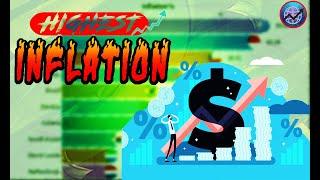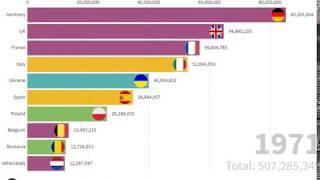Top 10 Country With Highest GDP | Updated | 1960-2019
Description
GDP ( full form GRASS DOMESTIC PRODUCT ) is the market value of all final goods and services from a nation in a given year. Countries are sorted by nominal GDP estimates from financial and statistical institutions, which are calculated at market or government official exchange rates. Nominal GDP does not take into account differences in the cost of living in different countries, and the results can vary greatly from one year to another based on fluctuations in the exchange rates of the country's currency. Such fluctuations may change a country's ranking from one year to the next, even though they often make little or no difference in the standard of living of its population.
The United States is the world's largest economy with a GDP of approximately $20.513 trillion, notably due to high average incomes, a large population, capital investment, low unemployment, high consumer spending, a relatively young population, and technological innovation. Tuvalu is the world's smallest national economy, with a GDP of about $32 million, because of its very small population, a lack of natural resources, reliance on foreign aid, negligible capital investment, demographic problems, and low average incomes.
The three largest economies in the world as measured by nominal GDP are the United States, China, and Japan. Economic growth and prosperity are impacted by a wide array of factors, namely investment in workforce education, production output (as determined by investment in physical capital), natural resources, and entrepreneurship. The economies of the U.S., China, and Japan all have a unique combination of these factors that have led to economic growth over time, as all animated in video
.
Although the rankings of national economies have changed considerably over time, the United States has maintained its top position since the Gilded Age, a time period in which its economy saw rapid expansion, surpassing the British Empire and Qing dynasty in aggregate output. Since China's transition to a market-based economy through controlled privatisation and deregulation, the country has seen its ranking increase from ninth in 1978 to second to only the United States in 2016 as economic growth accelerated and its share of global nominal GDP surged from 2% in 1980 to 15% in 2016.India has also experienced a similar economic boom since the implementation of economic liberalisation in the early 1990s. When supranational entities are included, the European Union is the second largest economy in the world. It was the largest from 2004, when ten countries joined the union, to 2014, after which it was surpassed by the United States.
shortlisted by : GDP Ranked by Country 2020 - Worldpopulationreview.com
Music : https://www.bensound.com
-~-~~-~~~-~~-~-
Please watch: "Prime Minister And President | For How Many Long Times | Tenure"
https://www.youtube.com/watch?v=TUY0teGXCtc
-~-~~-~~~-~~-~-

![[Statistics] Top T Countries With Highest Population ( 1960 - 2019 ) - Country Population #46](https://no-mar.com/uploads/thumbs/a7223789e-1.jpg)

![[Statistics] Top HI Countries With Highest Population ( 1960 - 2019 ) - Country Population #50](https://no-mar.com/uploads/thumbs/a5066a2ac-1.jpg)


![[Statistics] Top DEF Countries With Highest Population ( 1960 - 2019 ) - Country Population #48](https://no-mar.com/uploads/thumbs/5687dedc4-1.jpg)


![[Statistics] Top G Countries With Highest Population ( 1960 - 2019 ) - Country Population #49](https://no-mar.com/uploads/thumbs/0c53ae1d9-1.jpg)

![[Statistics] Top U Countries With Highest Population ( 1960 - 2019 ) - Country Population #57](https://no-mar.com/uploads/thumbs/639de0cee-1.jpg)

![[Statistics] Top C Countries With Highest Population ( 1960 - 2019 ) - Country Population #47](https://no-mar.com/uploads/thumbs/44792c097-1.jpg)







Comments